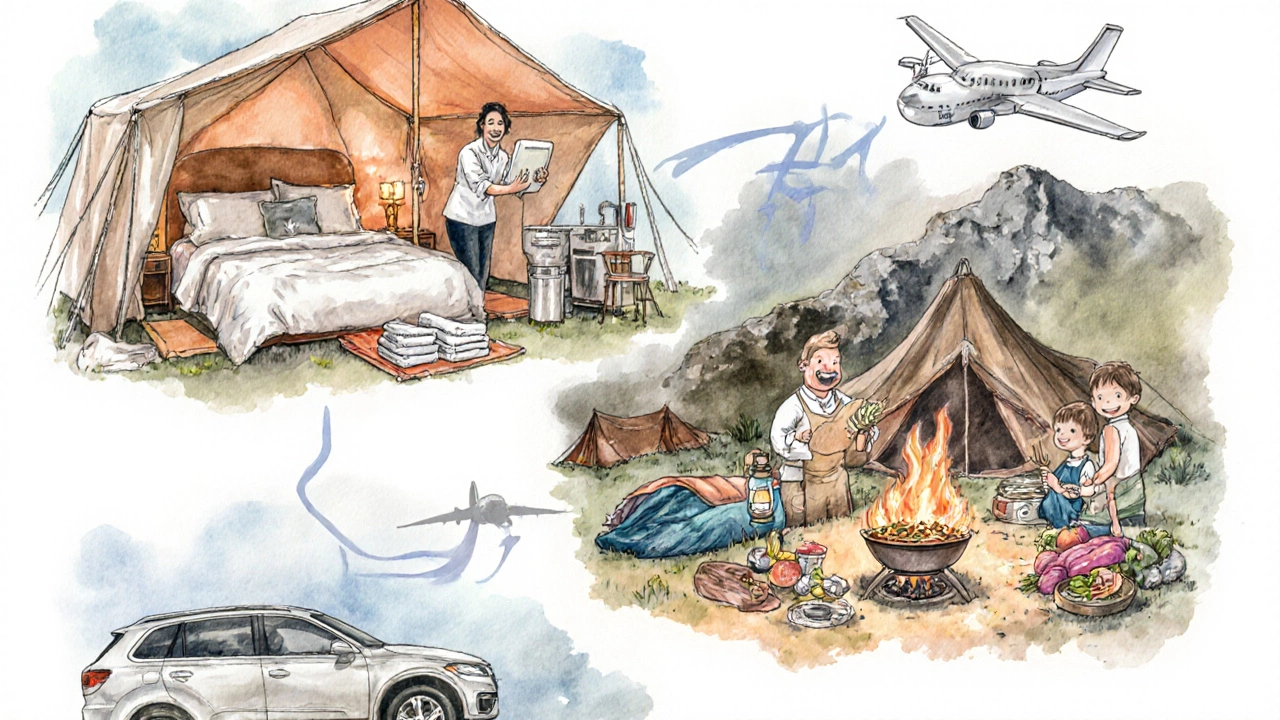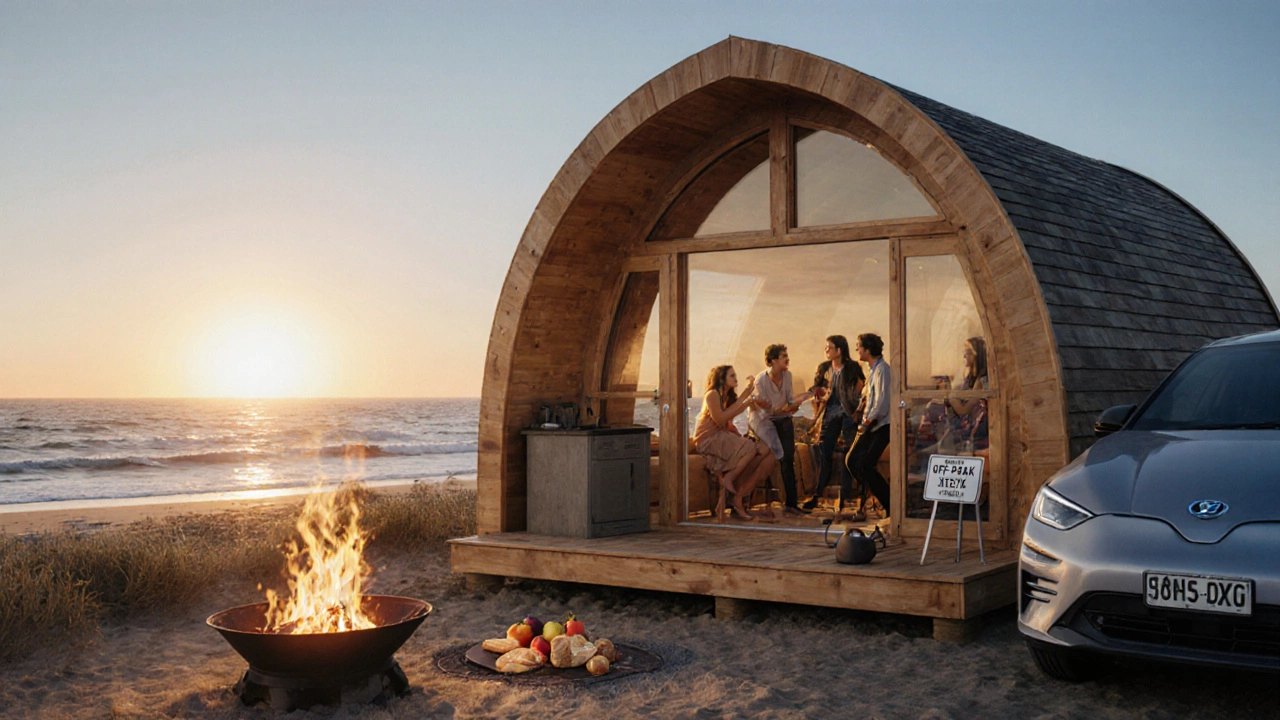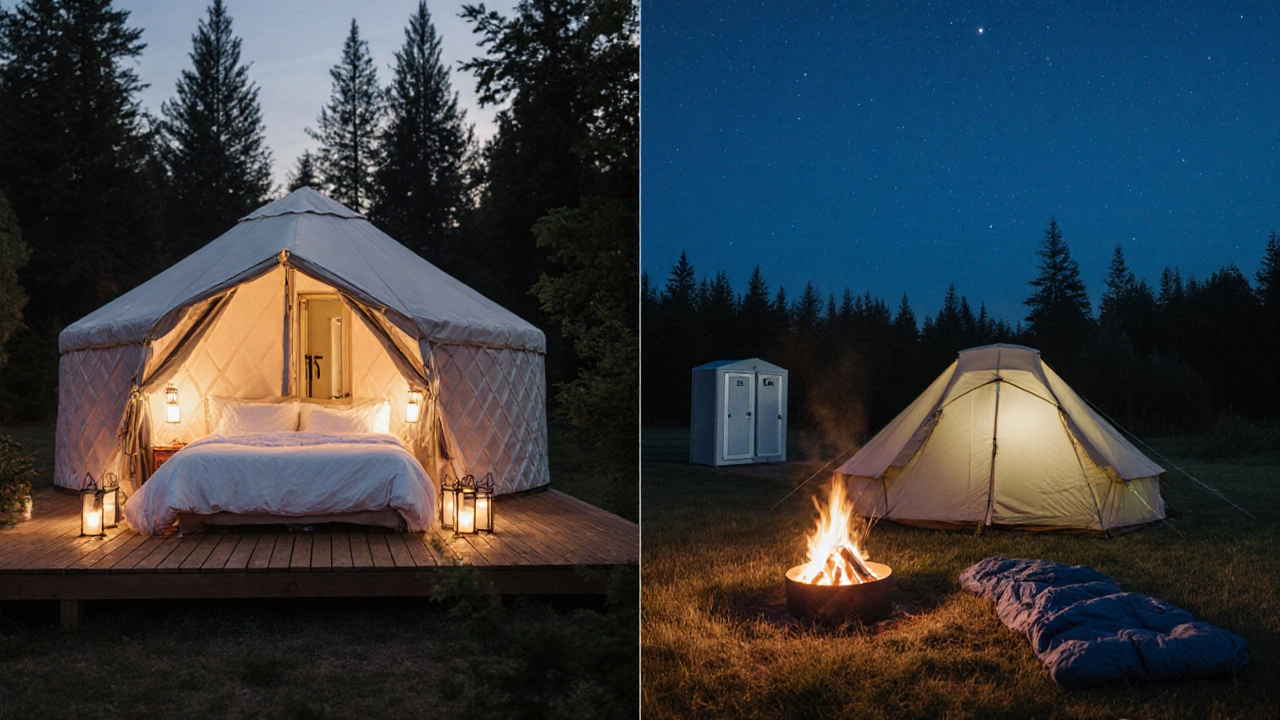Glamping vs Camping Cost Calculator
Glamping Details
Camping Details
Cost Comparison Result
Key Takeaways
- Glamping nights typically run $50‑$250USD more than basic camping, depending on location and amenities.
- Seasonality, site type (yurt, safari tent, treehouse) and extra services (meals, housekeeping) drive the price gap.
- Budget‑smart travelers can keep glamping costs down by choosing off‑peak dates, shared accommodations, or self‑catering options.
- Traditional camping remains the cheapest way to experience nature, especially when you bring your own gear.
- Consider the full experience cost - gear, food, travel - before deciding which style fits your wallet.
When you hear the term glamping is a hybrid of "glamorous" and "camping" that offers upscale tents, cabins, or pods with hotel‑like amenities, the first thought is often “that must cost a fortune.” But is that always true? Let’s break down the numbers, look at what you actually pay for, and see when glamping outruns traditional camping in price.
First, a quick definition of the other side of the coin: camping is a low‑cost outdoor activity where you pitch a tent or park an RV in a public or private campsite. No frills, you bring most of your gear, and you handle meals yourself. The core difference lies in the level of service and the type of shelter.
How Costs Are Built - The Main Price Drivers
Both glamping and camping have a few common cost categories, but the weight of each category shifts dramatically between the two.
- Accommodation fee - nightly charge for the shelter.
- Glamping: luxury tents, yurt, safari tent, treehouse, or tiny cabin.
- Camping: basic tent pitch, pull‑through site for an RV, or a primitive backcountry spot.
- Equipment rental - gear you need if you don’t own it.
- Glamping: usually all‑included (mattress, bedding, lighting).
- Camping: you rent or buy sleeping bags, stoves, lanterns.
- Food & beverage - meals, snacks, and drinks.
- Glamping: many sites offer on‑site chefs, ready‑made meals, or stocked mini‑fridges.
- Camping: you shop, cook, and clean yourself.
- Additional services - housekeeping, Wi‑Fi, spa, guided tours.
- Glamping: often part of the package or available as an extra.
- Camping: rarely available, usually at an extra fee.
- Travel logistics - how far you travel to the site.
- Glamping: tends to be closer to urban centers, meaning higher fuel or flight costs.
- Camping: can be deep in wilderness, sometimes reachable by a simple drive.
Average Nightly Rates in 2025
Below is a snapshot of typical nightly rates gathered from popular sites in the U.S., Europe, and Australia for the summer season. Prices are in US dollars and represent the median cost after taxes but before optional extras.
| Region | Accommodation | Avg Nightly Cost (USD) | Typical Amenities | Peak Season |
|---|---|---|---|---|
| Pacific Northwest, USA | Yurt | $120 | Bed, heating, private bathroom | June‑Sept |
| Pacific Northwest, USA | Standard Tent Pitch | $30 | Pitch‑in‑ground, shared restroom | June‑Sept |
| Southwest England | Safari Tent | £140 (~$175) | King‑size bed, en‑suite, fire pit | May‑Oct |
| Southwest England | Basic Pitch | £25 (~$30) | Ground space, communal washroom | May‑Oct |
| Queensland, Australia | Treehouse | AUD 260 (~$170) | Wooden deck, hot shower, breakfast | Dec‑Feb |
| Queensland, Australia | Campground Spot | AUD 40 (~$25) | Ground site, shared bathroom | Dec‑Feb |
Notice the pattern: glamping sites sit roughly $80‑$150 per night above a comparable campsite. That gap widens in high‑demand locales (e.g., the UK safari tent) and narrows when glamping operators adopt a “budget‑glamp” model that offers simpler canvas pods.

Beyond the Nightly Rate - Hidden Costs to Factor In
Even if the nightly price looks steep, the total glamping cost can sometimes beat camping when you count hidden expenses.
- Gear depreciation: Buying a quality four‑season tent, sleeping bag, and portable stove can set you back $500‑$1,000. If you only camp a few weekends a year, the cost per trip stays high.
- Food logistics: Cooking outdoors requires fuel canisters, seasonings, and cleanup supplies. A family of four can spend $40‑$70 on groceries for a weekend campsite.
- Transportation: Driving to remote backcountry sites adds fuel costs and wear‑and‑tear. Glamping sites near highways or airports reduce that expense.
When you add these elements, a basic campsite can approach a glamping price, especially for longer stays.
Budget‑Friendly Glamping Options
If the idea of a luxury tent excites you but your budget says “hold on,” consider these strategies.
- Off‑peak bookings: Rates drop 30‑50% during shoulder seasons (early spring, late fall).
- Group sharing: Many glamping pods accommodate 4‑6 guests. Splitting the cost can bring the per‑person price down to $30‑$60 per night.
- Self‑catering packages: Opt for sites that let you bring your own groceries rather than paying for chef‑prepared meals.
- Micro‑glamping: Platforms like Hipcamp and Glamping Hub list “canvas cabins” or “tiny pods” that start at $50‑$80 per night.
- Loyalty programs: Some operators offer repeat‑guest discounts or free upgrades after a certain number of stays.
When Camping Still Beats Glamping - The Value Equation
Traditional camping shines in three areas:
- Cost control: Even premium RV sites rarely exceed $70 per night.
- Flexibility: You can move camp daily, set up on public lands, or practice “wild camping” for free (where legal).
- Authentic nature immersion: No walls, no air‑conditioning - you’re truly living outdoors.
If your trip’s goal is pure adventure, star‑gazing, or learning survival skills, the extra cash for glamping may not add value.

Decision Checklist - Is Glamping Worth It for You?
Use this quick list to see whether the extra cost aligns with your priorities.
- Do you value a comfortable bed and hot shower over sleeping on the ground?
- Is travel time limited (e.g., weekend trip) and you need a “ready‑to‑go” setup?
- Are you traveling with kids, elders, or anyone with mobility challenges?
- Does the scenery or location require a reservation that only glamping sites offer?
- Is the experience part of a special occasion (anniversary, birthday) where luxury matters?
Answering “yes” to most of these suggests glamping’s premium will enhance your trip. If you’re mostly saying “no,” stick with classic camping.
Sample Budget Scenarios
Below are three typical trips to illustrate how the numbers play out.
| Scenario | Accommodation (3 nights) | Gear & Food | Travel | Total |
|---|---|---|---|---|
| Family of 4, Pacific Northwest | Glamping Yurt @ $120/night = $360 | Groceries $80, no gear rental | Fuel $60 | ≈ $500 |
| Couple, Southwest England | Safari Tent @ £140/night = £420 (~$525) | Chef meals $150 | Train $90 | ≈ $765 |
| Friends (6), Queensland | Treehouse @ AUD 260/night = AUD 780 (~$510) | Self‑catering $70 | Car rental $120 | ≈ $700 |
Compare these with a pure camping alternative for the same groups: the total drops by roughly 30‑45% because gear and meals become DIY.
Final Thoughts
Glamping certainly costs more per night than standard camping, but the true expense depends on what you include in the experience. Factor in gear, food, travel, and the value you place on comfort and convenience. If you’re after a hassle‑free night under the stars with a hot shower, paying the premium makes sense. If you crave rugged adventure and want to stretch every dollar, a tent and a camp stove will still give you unforgettable memories.
Frequently Asked Questions
Is glamping always more expensive than camping?
Generally yes, because glamping includes upgraded shelters and services. However, off‑peak rates, shared pods, or self‑catering options can bring the price close to a mid‑range campsite.
What are the cheapest glamping options?
Canvas cabins, tiny pods, or basic yurt sites that start around $50‑$80 per night are the most budget‑friendly. Booking during shoulder season can shave another 30% off.
Do I need to bring my own gear for glamping?
Most glamping sites provide bedding, lighting, and often a small fridge. You only need personal items like toiletries and, if you prefer, a portable charger.
Can I cook my own meals while glamping?
Yes, many glamping accommodations have a communal grill or a small kitchenette. Choosing a self‑catering package ensures you can bring groceries and save on restaurant fees.
How does season affect glamping prices?
Peak season (summer in the North, winter in the tropics) can raise nightly rates by 30‑50%. Shoulder months often see discounts, and some sites even offer winter specials for snow‑glamp experiences.
